
List of successful U-boat commanders
Encyclopedia
List of successful U-boat commanders contains lists of the most successful German
U-boat
commander
s in the two World War
s based on total tonnage
.
The tonnage figures (and sometimes the number of ships sunk) is still being debated among historians. This is often due to convoy
battles at night when an attacking "wolfpack" fired torpedo
es into the convoy and two commanders claimed the same ship. Although post-war research has eliminated most of those doubtful victims, there are still some in question.
With a higher score than Britain’s Wanklyn
, in HMS Upholder
, or America’s O’Kane
in USS Tang
(both later sunk), Gianfranco Gazzana-Priaroggia
and Leonardo da Vinci
were the most successful non-German submariner and submarine in the conflict.
But the Aces of the Deep were the ten German
U-Boat
commanders during World War II
who sank the most enemy merchant ships during their naval services, ranked according to the total tonnage of the ships they sank. The term is related to flying ace
, a World War I
name for a pilot who shot down five or more enemy planes. The currently accepted list is as follows:
Germany
Germany , officially the Federal Republic of Germany , is a federal parliamentary republic in Europe. The country consists of 16 states while the capital and largest city is Berlin. Germany covers an area of 357,021 km2 and has a largely temperate seasonal climate...
U-boat
U-boat
U-boat is the anglicized version of the German word U-Boot , itself an abbreviation of Unterseeboot , and refers to military submarines operated by Germany, particularly in World War I and World War II...
commander
Commander
Commander is a naval rank which is also sometimes used as a military title depending on the individual customs of a given military service. Commander is also used as a rank or title in some organizations outside of the armed forces, particularly in police and law enforcement.-Commander as a naval...
s in the two World War
World war
A world war is a war affecting the majority of the world's most powerful and populous nations. World wars span multiple countries on multiple continents, with battles fought in multiple theaters....
s based on total tonnage
Tonnage
Tonnage is a measure of the size or cargo carrying capacity of a ship. The term derives from the taxation paid on tuns or casks of wine, and was later used in reference to the weight of a ship's cargo; however, in modern maritime usage, "tonnage" specifically refers to a calculation of the volume...
.
The tonnage figures (and sometimes the number of ships sunk) is still being debated among historians. This is often due to convoy
Convoy
A convoy is a group of vehicles, typically motor vehicles or ships, traveling together for mutual support and protection. Often, a convoy is organized with armed defensive support, though it may also be used in a non-military sense, for example when driving through remote areas.-Age of Sail:Naval...
battles at night when an attacking "wolfpack" fired torpedo
Torpedo
The modern torpedo is a self-propelled missile weapon with an explosive warhead, launched above or below the water surface, propelled underwater towards a target, and designed to detonate either on contact with it or in proximity to it.The term torpedo was originally employed for...
es into the convoy and two commanders claimed the same ship. Although post-war research has eliminated most of those doubtful victims, there are still some in question.
World War I
This list contains the most successful German U-boats commanders during the First World War based on total tonnage. Only sunk commercial vessels are included, not military (warships) nor damaged ships.| # | Commander | Patrols | Ships sunk | Tonnage | Notes | Picture |
|---|---|---|---|---|---|---|
| 1 | Lothar von Arnauld de la Perière | 15 | 194 | 453,716 tons | Lothar von Arnauld de la Perière (1886–1941) was the most successful U-boat commander of World War I and of any submarine commander in history. Between 1915 and 1918, he made 14 patrols in command of , sinking 189 merchant vessels and two gunboats. He transferred to in May 1918 and sank a further five merchant ships, making 194 ships sunk totalling 453,716 GRT. After serving as an instructor in the Turkish Navy Turkish Navy The Turkish Navy is the naval warfare service branch of the Turkish Armed Forces.- Ottoman fleet after Mudros :Following the demise of the Ottoman Empire in the aftermath of World War I, on November 3, 1918, the fleet commander of the Ottoman Navy, Liva Amiral Arif Pasha, ordered all flags to be... between 1932–1938, he returned to the Kriegsmarine Kriegsmarine The Kriegsmarine was the name of the German Navy during the Nazi regime . It superseded the Kaiserliche Marine of World War I and the post-war Reichsmarine. The Kriegsmarine was one of three official branches of the Wehrmacht, the unified armed forces of Nazi Germany.The Kriegsmarine grew rapidly... and during World War II served as naval commandant for western France with the rank of Vizeadmiral. He was killed in February 1941 when his aircraft crashed on take off at Le Bourget Airport, Paris Paris – Le Bourget Airport Paris – Le Bourget Airport is an airport located in Le Bourget, Bonneuil-en-France, and Dugny, north-northeast of Paris, France. It is now used only for general aviation as well as air shows... . |
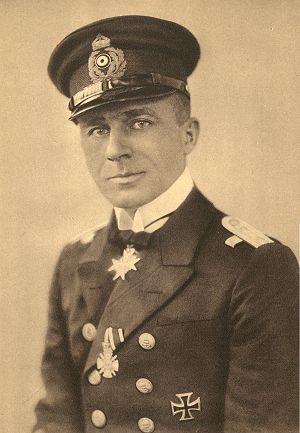 |
| 2 | Walther Forstmann Walther Forstmann Captain Walther Forstmann was one of the most successful and highly decorated German U-boat commanders in the Kaiserliche Marine during World War I... |
47 | 146 | 384,300 tons | Walther Forstmann (1883–1973) commanded and on 47 patrols and sank 146 ships for a total of 384,304 GRT. In 1921 he qualified as an attorney Lawyer A lawyer, according to Black's Law Dictionary, is "a person learned in the law; as an attorney, counsel or solicitor; a person who is practicing law." Law is the system of rules of conduct established by the sovereign government of a society to correct wrongs, maintain the stability of political... and worked in the steel and coal industries, as well as being active in the German People's Party German People's Party The German People's Party was a national liberal party in Weimar Germany and a successor to the National Liberal Party of the German Empire.-Ideology:... . Forstmann served on the staff of the Kriegsmarine Kriegsmarine The Kriegsmarine was the name of the German Navy during the Nazi regime . It superseded the Kaiserliche Marine of World War I and the post-war Reichsmarine. The Kriegsmarine was one of three official branches of the Wehrmacht, the unified armed forces of Nazi Germany.The Kriegsmarine grew rapidly... during World War II. |
 |
| 3 | Max Valentiner Max Valentiner Captain Christian August Max Ahlmann Valentiner was a German U-boat commander during World War I.He was the third highest-scoring U-boat commander of the war, and was awarded the Pour le Mérite, the highest Prussian military order until the end of the war, for his achievements.He was also branded... |
* | 150 | 299,300 tons | Max Valentiner (1883–1949) commanded and , and sank 150 ships for a total of 299,300 GRT. Branded a "war criminal" by the Allies for a series of incidents, including the sinking of , Valentiner went into hiding for a while at the end of the war. During World War II, Valentiner was commander of a unit inspecting new U-boats before commissioning. | 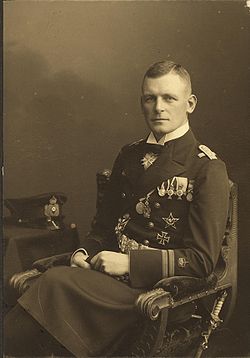 |
| 4 | Otto Steinbrinck Otto Steinbrinck Brigadier General Otto Steinbrinck was a German industrialist and an accused in the Nuremberg Flick Trial.... |
* | * | 231,614 tons | Otto Steinbrinck (1888–1949) commanded several submarines during World War I, sinking a total of 231,614 GRT of shipping. After the war he worked in the iron and steel industry. Steinbrinck joined the Nazi Party in 1933, and became a member of the SS Schutzstaffel The Schutzstaffel |Sig runes]]) was a major paramilitary organization under Adolf Hitler and the Nazi Party. Built upon the Nazi ideology, the SS under Heinrich Himmler's command was responsible for many of the crimes against humanity during World War II... , rising to the rank of Brigadeführer Brigadeführer SS-Brigadeführer was an SS rank that was used in Nazi Germany between the years of 1932 and 1945. Brigadeführer was also an SA rank.... , while remaining active in industry. In 1945, he was arrested and faced charges at the Flick Trial Flick Trial The United States of America vs. Friedrich Flick, et al. or Flick trial was the fifth of twelve Nazi war crimes trials held by United States authorities in their occupation zone Germany after World War II... . In December 1947, he was sentenced to six years imprisonment in Landsberg Prison Landsberg Prison Landsberg Prison is a penal facility located in the town of Landsberg am Lech in the southwest of the German state of Bavaria, about west of Munich and south of Augsburg.... , but died two years into his sentence. |
|
| 5 | Hans Rose Hans Rose Lieutenant Commander Hans Rose was one of the most successful and highly decorated German U-boat commander in the Kaiserliche Marine during .Rose was one of the most respected and brave U-boat commanders and famous for his humanity and fairness in battle... |
* | 79 | 213,900 tons | Hans Rose (1885–1969) commanded between 1916–1918, sinking 79 merchant ships for a total of 213,987 GRT, as well as the , the first American destroyer Destroyer In naval terminology, a destroyer is a fast and maneuverable yet long-endurance warship intended to escort larger vessels in a fleet, convoy or battle group and defend them against smaller, powerful, short-range attackers. Destroyers, originally called torpedo-boat destroyers in 1892, evolved from... to be lost during the war. Rose commanded a U-boat training unit in 1940. |
|
| 6 | Walther Schwieger Walther Schwieger Lieutenant Walther Schwieger was a German U-boat commander during the First World War, noted for his role in the sinking of the Lusitania.... |
34 | 49 | 183,883 tons | Schwieger (1885–1917) commanded the , and , sinking 49 ships for a total of 183,883 GRT in 34 patrols. One of these was passenger liner , which led to the United States' eventual entry into the war. Schwieger was killed when U-88 was sunk by a British mine off the Dutch coast in September 1917. | |
| 7 | Reinhold Saltzwedel Reinhold Saltzwedel Oberleutnant zur See Reinhold Saltzwedel was a successful and highly decorated German U-boat commander in the Kaiserliche Marine during World War I.Saltzwedel sank a total of 111 merchant vessels for... |
* | 111 | 170,526 tons | Reinhold Saltzwedel (1889–1917) commanded six U-boats during World War I, sinking 111 merchant vessels for a total of 170,526 GRT. He was killed in December 1917 when was sunk by a mine off the Isle of Wight Isle of Wight The Isle of Wight is a county and the largest island of England, located in the English Channel, on average about 2–4 miles off the south coast of the county of Hampshire, separated from the mainland by a strait called the Solent... . |
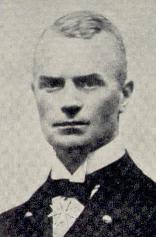 |
| 8 | Johannes Lohs Johannes Lohs Lieutenant junior grade Johannes Lohs was a successful and highly decorated German U-boat commander in the Kaiserliche Marine during World War I.... |
* | * | 165,000 tons | Johannes Lohs (1889–1918) commanded and , and sank a total of 165,000 GRT of shipping. Lohs was killed when UB-57 was lost in the North Sea North Sea In the southwest, beyond the Straits of Dover, the North Sea becomes the English Channel connecting to the Atlantic Ocean. In the east, it connects to the Baltic Sea via the Skagerrak and Kattegat, narrow straits that separate Denmark from Norway and Sweden respectively... in August 1918. |
|
| 9 | Waldemar Kophamel Waldemar Kophamel Commander Waldemar Kophamel was a successful and highly decorated German U-boat commander in the Kaiserliche Marine during World War I.... |
* | 54 | 148,852 tons | Waldemar Kophamel (1880–1934) commanded and , and sank 54 ships for a total of 148,852 GRT. | |
| 10 | Otto Schultze Otto Schultze Otto Schultze was a Generaladmiral with the Kriegsmarine during World War II and a recipient of the Pour le Mérite during World War I. The Pour le Mérite was the Kingdom of Prussia's highest military order for German soldiers until the end of World War I... |
* | 53 | 132,531 tons | Otto Schultze (1884–1966) commanded and sank 52 ships for a total of 132,531 GRT plus one warship for a further 5,250 GRT. |
World War II
This list contains the most successful German U-boats commanders during the Second World War based on total tonnage. Only sunk commercial vessels are included, not military (warships) nor damaged ships.With a higher score than Britain’s Wanklyn
Malcolm David Wanklyn
Lieutenant Commander Malcolm David Wanklyn VC, DSO & Two Bars was the Allies' most successful submariner in the Second World War in terms of tonnage sunk, and received the Victoria Cross, the highest and most prestigious award for gallantry in the face of the enemy that can be awarded to British...
, in HMS Upholder
HMS Upholder (P37)
HMS Upholder was a Royal Navy U-class submarine built by Vickers-Armstrong at Barrow-in-Furness. She was laid down on 30 October 1939, launched on 8 July 1940 by Mrs. Doris Thompson, wife of a director of the builders. The submarine was commissioned on 31 October 1940...
, or America’s O’Kane
Richard O'Kane
Rear Admiral Richard Hetherington “Dick” O'Kane was a United States Navy submarine commander in World War II, who received a Medal of Honor for his service on the...
in USS Tang
USS Tang (SS-306)
USS Tang was a Balao-class submarine of World War II. She was built and launched in 1943.In her short career, the Tang sank 33 ships displacing 116,454 tons Her commanding officer received the Medal of Honor for her last two engagements...
(both later sunk), Gianfranco Gazzana-Priaroggia
Gianfranco Gazzana-Priaroggia
Gianfranco Gazzana Priaroggia was an officer in the Italian Royal Navy . Gazzana-Priaroggia commanded multiple Italian submarines during World War II...
and Leonardo da Vinci
Italian submarine Leonardo da Vinci
Leonardo da Vinci was a of the Italian navy during World War II. The unit operated in the Atlantic from September 1940 until its loss in May 1943, and became the top scoring non-German submarine of the all war.-Construction:...
were the most successful non-German submariner and submarine in the conflict.
But the Aces of the Deep were the ten German
Germany
Germany , officially the Federal Republic of Germany , is a federal parliamentary republic in Europe. The country consists of 16 states while the capital and largest city is Berlin. Germany covers an area of 357,021 km2 and has a largely temperate seasonal climate...
U-Boat
U-boat
U-boat is the anglicized version of the German word U-Boot , itself an abbreviation of Unterseeboot , and refers to military submarines operated by Germany, particularly in World War I and World War II...
commanders during World War II
World War II
World War II, or the Second World War , was a global conflict lasting from 1939 to 1945, involving most of the world's nations—including all of the great powers—eventually forming two opposing military alliances: the Allies and the Axis...
who sank the most enemy merchant ships during their naval services, ranked according to the total tonnage of the ships they sank. The term is related to flying ace
Flying ace
A flying ace or fighter ace is a military aviator credited with shooting down several enemy aircraft during aerial combat. The actual number of aerial victories required to officially qualify as an "ace" has varied, but is usually considered to be five or more...
, a World War I
World War I
World War I , which was predominantly called the World War or the Great War from its occurrence until 1939, and the First World War or World War I thereafter, was a major war centred in Europe that began on 28 July 1914 and lasted until 11 November 1918...
name for a pilot who shot down five or more enemy planes. The currently accepted list is as follows:
| # | Commander | Patrols | Ships sunk | Tonnage | Notes | Picture |
|---|---|---|---|---|---|---|
| 1 | Otto Kretschmer Otto Kretschmer Flotilla Admiral Otto Kretschmer was a German U-boat commander in the Second World War and later an admiral in the Bundesmarine. From September 1939 until being captured in March 1941, he sank 47 ships, a total of 274,333 tons. For this he received the Knight's Cross of the Iron Cross with Oak... |
16 | 47 | 273,043 tons | Otto Kretschmer (1912–1998) was the most successful of the World War II Aces of the Deep. As commander of , and he sank 47 merchant ships totalling 272,043 tons in a remarkably short period of time, being captured in March 1941 and spending the rest of the war in the Bowmanville POW camp Bowmanville POW camp The Bowmanville POW camp Camp 30 was a Canadian-run POW camp for German soldiers during World War II located in Bowmanville, Ontario.Prisoners Otto Kretschmer and Wolfgang Heyda were the subject of an elaborate escape attempt named Operation Kiebitz.... , Canada Canada Canada is a North American country consisting of ten provinces and three territories. Located in the northern part of the continent, it extends from the Atlantic Ocean in the east to the Pacific Ocean in the west, and northward into the Arctic Ocean... . After the war, he rejoined the Bundesmarine, and became the Chief of Staff of the NATO Command COMNAVBALTAP Allied Forces Baltic Approaches Allied Forces Baltic Approaches was the NATO command with responsibility for the Baltic Sea area. It was in existence from 1962 to 2002.The NATO command Baltic Approaches was created on 8 January 1962, with headquarters in Karup, Denmark... in May 1965. He retired in September 1970 with a rank of Flottillenadmiral. |
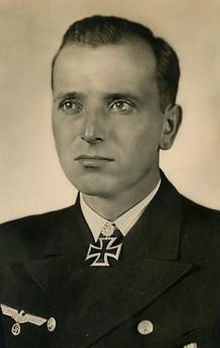 |
| 2 | Wolfgang Lüth Wolfgang Lüth Kapitän zur See Wolfgang August Eugen Lüth , was the second most successful German U-boat ace of World War II... |
15 | 46 | 225,204 tons | Wolfgang Lüth (1913–1945) was given command of in December 1939, going on to command , , and , and sinking 46 merchant ships for a total 225,204 tons in 15 patrols, including one of 205 days, the second longest of the war. In January 1944 Lüth took command of 22nd U-boat Flotilla, before being appointed commander of the Marineschule Mürwik in July. Lüth was mistakenly shot and killed by a German sentry on 13 May 1945. | 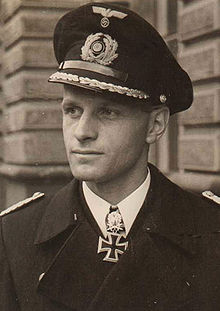 |
| 3 | Erich Topp Erich Topp Rear Admiral Erich Topp was the third most successful of German U-Boot Experten commanders of World War II. He was also a recipient of the Knight's Cross of the Iron Cross with Oak Leaves and Swords... |
12 | 35 | 197,460 tons | Erich Topp (1914–2005) commanded and in 1940–1941, and sank 35 merchant ships for a total of 197,460 tons. He commanded the tactical training unit 27th U-boat Flotilla from late 1942, and served briefly as commander of the Type XXI German Type XXI submarine Type XXI U-boats, also known as "Elektroboote", were the first submarines designed to operate primarily submerged, rather than as surface ships that could submerge as a means to escape detection or launch an attack.-Description:... Elektroboote and just before the end of the war. He rejoined the Bundesmarine in 1956, reaching the rank of Konteradmiral before retiring in 1969. |
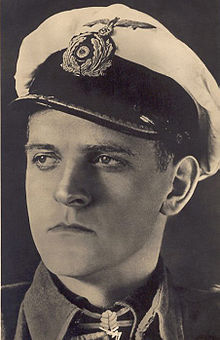 |
| 4 | Heinrich Liebe Heinrich Liebe Commander Heinrich Liebe was a highly decorated German naval officer who served as a U-boat commander during World War II until transferred to Oberkommando der Kriegsmarine . He sank 34 ships for a total of , placing him fourth on the Aces of the Deep list... |
9 | 34 | 187,267 tons | Heinrich Liebe (1908–1997) commanded between 1938–1941, sinking 34 ships for a total of 187,267 GRT. In 1941 Liebe was assigned to the staff of Oberkommando der Marine Oberkommando der Marine The Oberkommando der Marine was Nazi Germany's Naval High Command and the highest administrative and command authority of the Kriegsmarine. It was officially formed from the Marineleitung of the Reichswehr on 11 January 1936. In 1937 it was combined with the newly formed Seekriegsleitung... , and from August 1944 was on the staff of the BdU Befehlshaber der U-Boote Befehlshaber der U-Boote was the title of the supreme commander of the Kriegsmarines U-boat Arm during World War II. The term also referred to the Command HQ of the U-boat arm itself.... . After the war Liebe returned to his hometown in the Soviet sector. As he refused to train Soviet submariners, he was allowed only a series of menial occupations. |
 |
| 5 | Viktor Schütze | 7 | 35 | 180,073 tons | Viktor Schütze (1906–1950) commanded and , sinking 35 merchant ships totalling 180,073 tons, before being appointed commander of 2nd U-boat Flotilla in August 1941. He became the FdU Führer der U-Boote The post of Führer der U-Boote was the senior commanding officer of the submarine service in the pre-World War II German Kriegsmarine, and the title of several senior commands during the war. From January 1936 and until 17 October 1939, Karl Dönitz served in this position... Ausbildungsflottillen (Commander of the Training Flotillas) in the Baltic Sea Baltic Sea The Baltic Sea is a brackish mediterranean sea located in Northern Europe, from 53°N to 66°N latitude and from 20°E to 26°E longitude. It is bounded by the Scandinavian Peninsula, the mainland of Europe, and the Danish islands. It drains into the Kattegat by way of the Øresund, the Great Belt and... in March 1943. He spent a year in Allied captivity after the war. |
|
| 6 | Heinrich Lehmann-Willenbrock | 10 | 25 | 179,125 tons | Heinrich Lehmann-Willenbrock (1911–1986) commanded the , and , sinking 25 merchant ships for a total of 179,125 tons. In May 1942 Willenbrock took command of 9th U-boat Flotilla, transferring to 11th U-boat Flotilla in December 1944. After spending a year in captivity after the German surrender Victory in Europe Day Victory in Europe Day commemorates 8 May 1945 , the date when the World War II Allies formally accepted the unconditional surrender of the armed forces of Nazi Germany and the end of Adolf Hitler's Third Reich. The formal surrender of the occupying German forces in the Channel Islands was not... , Willenbrock served as captain on merchant ships, and from 1964 commanded the German nuclear-powered freighter Otto Hahn Otto Hahn (ship) Otto Hahn was one of only four nuclear-powered cargo vessels so far built. Planning of a German-built trade and research vessel to test the feasibility of nuclear power in civil service began in 1960, and Otto Hahns keel was laid down in 1963 by Howaldtswerke Deutsche Werft AG of Kiel... . Willenbrock acted as advisor to the film Das Boot Das Boot Das Boot is a 1981 German epic war film written and directed by Wolfgang Petersen, produced by Günter Rohrbach, and starring Jürgen Prochnow, Herbert Grönemeyer, and Klaus Wennemann... , based on an account of one of his own war patrols in U-96. |
|
| 7 | Karl-Friedrich Merten Karl-Friedrich Merten Captain Karl-Friedrich Merten was a German U-boat commander during World War II. He is credited with the sinking of 27 ships for a total of of allied shipping. For this achievement he was awarded the Knight's Cross with Oak Leaves... |
5 | 27 | 170,151 tons | Karl-Friedrich Merten (1905–1993), in command of , sailed in five patrols in 1941–1942 sinking 27 ships for a total of 170,151 tons. He commanded 26th U-boat Flotilla in early 1943, and this and other training appointments curtailed his operational career. After the war he made a new career in shipbuilding. | 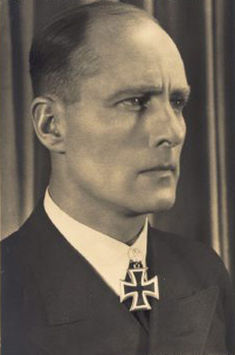 |
| 8 | Herbert Schultze Herbert Schultze Lieutenant Commander Herbert Schultze , was a German U-boat commander of the Kriegsmarine during World War II. He commanded for eight patrols during the early part of the war, sinking and earning him eighth place on the Aces of the Deep list... |
8 | 26 | 169,709 tons | Herbert Schultze (1909–1987) commissioned in 1939, and in eight patrols sank 26 merchant ships for a total of 169,709 tons. Schultze took command of 3rd U-boat Flotilla in July 1941, until joining the staff of Marinegruppe Nord in March 1942. In December 1942 he was assigned to the staff of Admiral Karl Dönitz Karl Dönitz Karl Dönitz was a German naval commander during World War II. He started his career in the German Navy during World War I. In 1918, while he was in command of , the submarine was sunk by British forces and Dönitz was taken prisoner... . In March 1944 he was assigned to Marineschule Mürwik, where he remained until the end of the war. In 1956 Schultze joined the Bundesmarine and served in a series of staff positions until 1968. |
 |
| 9 | Günther Prien Günther Prien Lieutenant Commander Günther Prien was one of the outstanding German U-boat aces of the first part of the Second World War, and the first U-boat commander to win the Knight's Cross of the Iron Cross. Under Prien's command, the submarine sank over 30 Allied ships totaling about... |
10 | 30 | 162,769 tons | Günther Prien (1908–1941) was given command of in December 1938, and sank over 30 Allied merchant ships for a total of 162,769 GRT. His most famous exploit was infiltrating the British Home Fleet's base at Scapa Flow Scapa Flow right|thumb|Scapa Flow viewed from its eastern endScapa Flow is a body of water in the Orkney Islands, Scotland, United Kingdom, sheltered by the islands of Mainland, Graemsay, Burray, South Ronaldsay and Hoy. It is about... in October 1939 and sinking the battleship - which won him the Knight's Cross of the Iron Cross Knight's Cross of the Iron Cross The Knight's Cross of the Iron Cross was a grade of the 1939 version of the 1813 created Iron Cross . The Knight's Cross of the Iron Cross was the highest award of Germany to recognize extreme battlefield bravery or successful military leadership during World War II... , the first U-boat commander to do so. Prien was lost when U-47 went missing on 7 March 1941 during an attack on Convoy OB 293 south of Iceland Iceland Iceland , described as the Republic of Iceland, is a Nordic and European island country in the North Atlantic Ocean, on the Mid-Atlantic Ridge. Iceland also refers to the main island of the country, which contains almost all the population and almost all the land area. The country has a population... . |
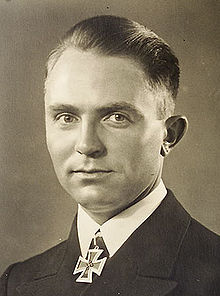 |
| 10 | Georg Lassen Georg Lassen Lieutenant Commander Georg Lassen is a former German U-boat captain who served with the Kriegsmarine during World War II. He was a Watchkeeping Officer on at the outbreak of the war and later the skipper of the and winner of the Iron Cross. He sank 26 ships for a total of during 4 patrols,... |
4 | 26 | 156,082 tons | Georg Lassen (1915–) took command of and sailed on four combat patrols in 1942 and 1943, sinking 26 ships for a total of 156,082 GRT, a remarkable average of 39,020 GRT per patrol. In June 1943 Lassen was appointed tactical instructor and commander of the "Offiziers-kompanie" in 1. U-boot-Lehr-Division, a training unit for future U-boat commanders. As of 2011, he is the last surviving Ace of the Deep and among the last living of the most successful Second World War German U-boat commanders. | |
| 11 | Joachim Schepke Joachim Schepke Lieutenant-Commander Joachim Schepke was a German U-boat commander during World War II. He was the seventh recipient of the Knight's Cross of the Iron Cross with Oak Leaves . The Knight's Cross of the Iron Cross and its higher grade Oak Leaves was awarded by the Third Reich to recognise extreme... |
14 | 37 | 155,882 tons | Joachim Schepke (1912–1941) took command of in 1938, sailed on five combat patrols, and sank two ships. From January to April 1940 he commanded , sinking another nine ships. After a brief spell serving in a staff position Schepke took command of in which he sank another 25 ships. This gave him a total of 37 ships sunk for a total of 155,882 GRT. On 17 March 1941 while attacking Convoy HX 112 U-100 was forced to the surface by depth charge Depth charge A depth charge is an anti-submarine warfare weapon intended to destroy or cripple a target submarine by the shock of exploding near it. Most use explosives and a fuze set to go off at a preselected depth in the ocean. Depth charges can be dropped by either surface ships, patrol aircraft, or from... s from and , detected on radar, and consequently rammed by Vanoc. Schepke and 37 crewmen were killed; only six were rescued. |
 |
| 12 | Werner Henke Werner Henke Lieutenant Commander Werner Henke born in Thorn in Germany was the commander of during the Second Battle of the Atlantic of World War II. U-515 was sunk by the American task group 22.3, commanded by Daniel V... |
7 | 24 | 155,714 tons | Werner Henke (1909–1944) took command of in February 1942, sinking 24 ships totaling 155,714 GRT, before U-515 was sunk by United States Navy United States Navy The United States Navy is the naval warfare service branch of the United States Armed Forces and one of the seven uniformed services of the United States. The U.S. Navy is the largest in the world; its battle fleet tonnage is greater than that of the next 13 largest navies combined. The U.S... aircraft and destroyers north of Madeira Madeira Madeira is a Portuguese archipelago that lies between and , just under 400 km north of Tenerife, Canary Islands, in the north Atlantic Ocean and an outermost region of the European Union... . Henke was taken to a secret interrogation center known only as P. O. Box 1142 P. O. Box 1142 P.O. Box 1142 was a secret American military intelligence facility that operated during World War II. The American Military Intelligence Service had two special wings whose core duty was to interview the Prisoners of War , known as MIS -X and MIS -Y. They were known by their codename, the mailing... in Fort Hunt, Virginia Fort Hunt, Virginia Fort Hunt is a census-designated place in Fairfax County, Virginia, United States. . It is one of the wealthiest places in the United States with a median household income surpassing that of Greenwich, Connecticut and Malibu, California, and is most famous for the site of former P.O... , where his interrogator threatened to send him England to face war crime charges if he did not cooperate. On 15 June 1944, Henke ran to the fence surrounding the interrogation center and began to climb over. He continued after a guard ordered him to stop and was shot and killed. |
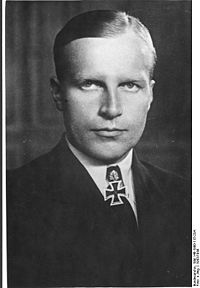 |
| 13 | Carl Emmermann Carl Emmermann Lieutenant Commander Carl Emmermann was a German U-boat commander during World War II. In his time as commander, he succeeded in sinking 27 ships for a total tonnage of .Emmermann began his naval career in 1934... |
5 | 26 | 152,080 tons | Carl Emmermann (1915–1990) took command of in November 1941, completing five patrols, and sinking 26 ships for a total of 152,080 GRT. He became the commander of 6th U-boat Flotilla in November 1943, and in August 1944 became the chief of the Erprobungsgruppe Typ XXIII ("Type XXIII German Type XXIII submarine German Type XXIII submarines were the first so-called elektroboats to become operational. They were small coastal submarines designed to operate in the shallow waters of the North Sea, Black Sea and Mediterranean Sea, where larger Type XXI Elektro boats were at risk in World War II. They were so... Testing Group"). In March-April 1945 Emmermann was commander of , and in April–May 1945 he commanded 31st U-boat Flotilla in Hamburg. In the final days of the war he took part in infantry duty around Hamburg as commander of Marine-Battalion Emmermann. After the war he studied engineering and prospered in business. |
|
| 14 | Heinrich Bleichrodt Heinrich Bleichrodt Lieutenant Commander Heinrich Bleichrodt was one of the most successful German U-boat commander of the Second World War. From October 1939 until retiring from front line service in December 1943, he sank 25 ships for a total of . For this he received the Knight's Cross with Oak Leaves, among other... |
8 | 24 | 151,260 tons | Heinrich Bleichrodt (1909–1977) was given command of in 1940, sailing on two patrols, and sinking 15 ships totalling 79,295 GRT, including the - an unmarked evacuation transport. After briefly commanding , in June 1941 Bleichrodt took command of . He carried out six patrols, sinking 13 ships for a total of some 80,000 tons, to make a grand total of 24 merchant ships sunk, totalling 151,260 tons. Bleichrodt then served in a training post with 27th U-boat Flotilla and in the 2nd ULD (U-boat Training Division) as tactical instructor. In July 1944 he was appointed commander of 22nd U-boat Flotilla. After the war become a factory manager. |  |
| 15 | Robert Gysae Robert Gysae Robert Gysae was a Korvettenkapitän with the Kriegsmarine during World War II. He commanded and , sinking twenty-five ships on eight patrols, for a total of tons of Allied shipping, to become the fifteenth highest scoring U-Boat ace of World War II.-Career:Gysae joined the Reichsmarine in 1931... |
8 | 25 | 146,815 tons | Robert Gysae (1911–1989) commanded and , sinking 25 ships for a total on 146,815 GRT in eight patrols. In January 1944 he became commander of training unit 25th U-boat Flotilla. In April 1945, during the last month of the war, Gysae commanded the Marinepanzerjagd-Regiment 1, a naval anti-tank regiment. After the war he served in the Deutscher Minenräumdienst ("German Mine Sweeping Administration German Mine Sweeping Administration The German Mine Sweeping Administration was formed from former crews and vessels of the Nazi German Kriegsmarine for the purpose of mine sweeping after the Second World War, predominantly in the North Sea and Baltic Sea, and existed from June 1945 to January 1948.-History:The GMSA was formed on 21... ") for more than two years. In 1956 he joined the Bundesmarine, retiring in 1970 with the rank of Flottillenadmiral. |
 |
| 16 | Ernst Kals Ernst Kals Ernst Kals was a Kapitän zur See with the Kriegsmarine during World War II. He commanded the Type IXC U-boat on five patrols, and sank twenty ships, for a total of 145,656 tons of Allied shipping, becoming the sixteenth highest scoring U-Boat ace of World War II... |
5 | 20 | 145,656 tons | Ernst Kals (1905–1979) took command of in June 1941, and sank 20 ships on five patrols, for a total of 145,656 tons of Allied shipping. On 12 November 1942 during the Naval Battle of Casablanca Naval Battle of Casablanca The Naval Battle of Casablanca was a series of naval engagements fought between American ships covering the invasion of North Africa and Vichy French ships defending the neutrality of French Morocco in accordance with the Second Armistice at Compiègne during World War II... , he attacked the heavily guarded transport ships in Fedala Roads Mohammedia Mohammedia is a port city on the west coast of Morocco located between Casablanca and Rabat in the region of Greater Casablanca. It hosts the most important oil refinery of Morocco, Samir, which makes it the center of the Moroccan petrol... in Morocco, sinking three large troop ships for a total of 34,507 tons in five minutes. In January 1943 he became commander of 2nd U-boat Flotilla, where he remained to the end of the war. From May 1945 to January 1948 Kals was held in French captivity. |
|
| 17 | Johann Mohr Johann Mohr Johann Mohr was a Korvettenkapitän with the Kriegsmarine during World War II. He was also a recipient of the Knight's Cross of the Iron Cross with Oak Leaves... |
6 | 27 | 129,292 tons | Johann Mohr (1916–1943) assumed command of in September 1941, and sank 27 ships on six patrols, for a total of 129,292 GRT of Allied shipping. This includes four ships from Convoy ONS-92 sunk on the night of 12 May 1942, totalling 21,784 tons. Mohr was killed when U-124 was sunk with all hands on 2 April 1943 west of Oporto, Portugal, by the British corvette and the sloop Black Swan class sloop The Black Swan class and Modified Black Swan class were two classes of sloop of the Royal Navy and Royal Indian Navy. Thirteen Black Swans were launched between 1939 and 1943, including four for the Royal Indian Navy; twenty-four Modified Black Swans were launched between 1942 and 1945, including... . |
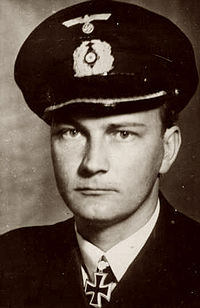 |
| 18 | Klaus Scholtz Klaus Scholtz Klaus Scholtz was a Kapitänleutnant with the Kriegsmarine during World War II. He commanded the Type IXB U-boat , sinking twenty-five ships on eight patrols, for a total of of Allied shipping, to become the eighteenth highest scoring U-Boat ace of World War II. He was also a recipient of the... |
8 | 25 | 128,190 tons | Klaus Scholtz (1908–1987) commanded from October 1940, sinking 25 ships on 8 patrols, for a total of 128,190 tons of Allied shipping. In October 1942 he formed and took command of 12th U-boat Flotilla. In August 1944 he attempted to lead his men back to Germany on foot, but they captured by American forces, and he spent the next 18 months in US captivity. Scholtz served in the Bundesgrenzschutz-See Bundesgrenzschutz Bundesgrenzschutz was the first federal police organization in Western Germany after World War II permitted by the Allied occupation authorities. In July 2005, the BGS was renamed Bundespolizei to reflect its transition to a multi-faceted police agency.It was established in 1951... from 1953 to 1956, then transferred to the Bundesmarine, serving as commander of several naval bases, including Kiel Kiel Kiel is the capital and most populous city in the northern German state of Schleswig-Holstein, with a population of 238,049 .Kiel is approximately north of Hamburg. Due to its geographic location in the north of Germany, the southeast of the Jutland peninsula, and the southwestern shore of the... , Cuxhaven, and Wilhelmshaven Wilhelmshaven Wilhelmshaven is a coastal town in Lower Saxony, Germany. It is situated on the western side of the Jade Bight, a bay of the North Sea.-History:... . He retired in 1966. |
|
| 19 | Adolf Cornelius Piening Adolf Piening Adolf Cornelius Piening was a Kapitänleutnant with the Kriegsmarine during World War II... |
8 | 25 | 126,664 tons | Adolf Piening (1910–1984) took command of in June 1941, and sank 25 ships for a total of 126,664 GRT in 8 patrols. From March 1944 Piening was the commander of 7th U-boat Flotilla. Piening made his last patrol in April 1945, laying mines off Saint-Nazaire Saint-Nazaire Saint-Nazaire , is a commune in the Loire-Atlantique department in western France.The town has a major harbour, on the right bank of the Loire River estuary, near the Atlantic Ocean. The town is at the south of the second-largest swamp in France, called "la Brière"... in . After the war Piening spent more than two years in Allied captivity. In 1956 he joined the Bundesmarine, serving for 13 years. |
|
| 20 | Helmut Witte Helmut Witte Helmut Witte was a Korvettenkapitän with the Kriegsmarine during World War II. As commander of the Type IXC U-boat , he sank twenty-three ships on four patrols, for a total of 119,554 tons of Allied shipping, to become the 20th highest scoring U-Boat ace of World War II. He was also a recipient of... |
4 | 23 | 119,554 tons | Helmut Witte (1915–2005) commissioned in October 1941 and in four patrols sank 23 ships totalling 119,554 GRT. From June 1943 he served in several staff positions. At the end of the war he spent two months in British captivity, then became a farm hand and factory worker. Later he had a successful business career. | |
| 21 | Günther Hessler Günther Hessler Günther Hessler was a Fregattenkapitän with the Kriegsmarine during World War II. He commanded the Type IXB U-boat , sinking twenty-one ships on three patrols, for a total of tons of Allied shipping, of which was sunk on one patrol alone... |
3 | 21 | 118,822 tons | Günther Hessler (1909–1968) commissioned in 1940, and on his first patrol sank four ships for a total of 18,514 tons. He became famous for his second patrol - the most successful of the entire war - sinking 14 ships for a total of 86,699 tons. His third patrol accounted for another three ships for a total of 13,641 tons, giving Hessler grand total of 21 ships sunk totalling 118,822 GRT. Hessler then transferred to the BdU Befehlshaber der U-Boote Befehlshaber der U-Boote was the title of the supreme commander of the Kriegsmarines U-boat Arm during World War II. The term also referred to the Command HQ of the U-boat arm itself.... to serve on the staff of his father-in-law Father-in-law A parent-in-law is a person who has a legal affinity with another by being the parent of the other's spouse. Many cultures and legal systems impose duties and responsibilities on persons connected by this relationship... Karl Dönitz Karl Dönitz Karl Dönitz was a German naval commander during World War II. He started his career in the German Navy during World War I. In 1918, while he was in command of , the submarine was sunk by British forces and Dönitz was taken prisoner... . After the war Hessler spent over a year in Allied captivity, and testified at the Nuremberg Trials Nuremberg Trials The Nuremberg Trials were a series of military tribunals, held by the victorious Allied forces of World War II, most notable for the prosecution of prominent members of the political, military, and economic leadership of the defeated Nazi Germany.... . In 1947 Hessler was commissioned by the British Royal Navy Royal Navy The Royal Navy is the naval warfare service branch of the British Armed Forces. Founded in the 16th century, it is the oldest service branch and is known as the Senior Service... to write The U-Boat War in the Atlantic. Assisted by Alfred Hoschatt, former BdU staff officer and commander of U-378, he completed the three volume work in 1951. |
|
| 22 | Ernst Bauer Ernst Bauer (Kapitän zur See) Ernst Bauer was a German U-boat commander of World War II. He commanded the U-boats and , sinking 25 ships on five patrols, for a total of of Allied shipping, to stand 22nd on the list of highest scoring U-Boat aces of World War II. He was also a recipient of the Knight's Cross of the Iron Cross... |
5 | 25 | 118,560 tons | Ernst Bauer (1914–1988) was given command of in March 1941, and conducted five combat patrols, sinking 25 merchant ships for a total of 118,560 GRT. In October 1944 he became commander of the training unit 27th U-boat Flotilla, and during the last month of war he was transferred to 26th U-boat Flotilla. Bauer rejoined the Bundesmarine in 1956 and held several staff positions before retiring in 1972. | |
| 23 | Engelbert Endrass Engelbert Endrass Lieutenant Engelbert Endrass was a German U-boat commander in World War II. He commanded the Type VIIB U-boat and the Type VIIC , sinking twenty-two ships on ten patrols, for a total of 118,528 tons of Allied shipping, to become the 23rd highest scoring U-Boat ace of World War II... |
10 | 22 | 118,528 tons | Engelbert Endrass (1911–1941) was 1.WO of when Günther Prien Günther Prien Lieutenant Commander Günther Prien was one of the outstanding German U-boat aces of the first part of the Second World War, and the first U-boat commander to win the Knight's Cross of the Iron Cross. Under Prien's command, the submarine sank over 30 Allied ships totaling about... took her into Scapa Flow Scapa Flow right|thumb|Scapa Flow viewed from its eastern endScapa Flow is a body of water in the Orkney Islands, Scotland, United Kingdom, sheltered by the islands of Mainland, Graemsay, Burray, South Ronaldsay and Hoy. It is about... and sank . In May 1940 Endrass took command of , and in eight war patrols sank 21 ships, before taking over in October 1941. He sank only one more ship, making 22 ships sunk totalling 118,528 tons in 10 patrols. He was killed when U-567 was sunk with all hands on 21 December 1941, by depth charges from the British sloop Grimsby class sloop With the realisation that war was approaching, 13 Grimsby class sloops were laid down in the mid to late 1930s. Of these eight were built in the United Kingdom for the Royal Navy, four in Australia for the Royal Australian Navy and one for India... and corvette Flower class corvette The Flower-class corvette was a class of 267 corvettes used during World War II, specifically with the Allied navies as anti-submarine convoy escorts during the Battle of the Atlantic... , northeast of the Azores Azores The Archipelago of the Azores is composed of nine volcanic islands situated in the middle of the North Atlantic Ocean, and is located about west from Lisbon and about east from the east coast of North America. The islands, and their economic exclusion zone, form the Autonomous Region of the... . |
|
| 24 | Reinhard Hardegen Reinhard Hardegen Lieutenant Commander Reinhard Hardegen is a German U-boat Commander who sank 22 ships, amounting to sunk, ranking him as the 24th most successful Commander in World War II. After the war, he spent a year in British captivity before running a successful oil company and serving in Bremen's... |
5 | 22 | 115,656 tons | Reinhard Hardegen (1913–) took command of in 1940 for a single patrol, then for another four patrols in 1941, sinking 22 merchant ships for a total of 115,656 GRT. In mid-1942, he became an instructor in 27th U-boat Flotilla, and from March 1943, served as chief of the torpedo school at Marineschule Mürwik. Hardegen served for few months in the Torpedowaffenamt (Torpedo Weapon Department) before serving as Battalion Commander in Marine Infanterie Regiment 6 from February 1945, taking part in the fighting around Bremen. Hardegen spent a year and a half in British captivity before starting a successful oil trading business, as well as serving as a member of Bremen's city council Landtag A Landtag is a representative assembly or parliament in German-speaking countries with some legislative authority.- Name :... (the Bürgerschaft Bürgerschaft of Bremen The Bremische Bürgerschaft is the state diet of the Free Hanseatic City of Bremen. It currently consists of 83 members from five parties. The current majority is a coalition of the Social Democratic Party and the Alliance '90/The Greens, supporting Mayor and Senate president Jens Böhrnsen... ) for 32 years. |
|
| 25 | Werner Hartmann Werner Hartmann Captain Werner Hartmann was a German U-boat commander in World War II. He sank 26 ships, amounting to over 115,000 tons sunk, ranking him as the 25th most successful commander in the war.-Career:... |
4 | 26 | 115,337 tons | Werner Hartmann (1902–1963) was commander of both and 2nd U-boat Flotilla from January–May 1940, but this proved inefficient, and BdU Befehlshaber der U-Boote Befehlshaber der U-Boote was the title of the supreme commander of the Kriegsmarines U-boat Arm during World War II. The term also referred to the Command HQ of the U-boat arm itself.... decided to direct the U-boats from land. After three patrols, and sinking 19 ships totalling 78,559 GRT, Hartmann moved to the BdU staff. In November 1940 he became commander of 2. Unterseeboots-Lehr-Division ("2nd U-boat Training Division"), and a year later took command of the 27th U-boat Flotilla. In November 1942 he took command of for a patrol to the Indian Ocean lasting 200 days, the third longest patrol ever undertaken, and sank 7 ships totalling 36,778 GRT, giving him a grand total of 26 ships sunk for 115,337 tons. In 1944 Hartmann became FdU Führer der U-Boote The post of Führer der U-Boote was the senior commanding officer of the submarine service in the pre-World War II German Kriegsmarine, and the title of several senior commands during the war. From January 1936 and until 17 October 1939, Karl Dönitz served in this position... Mittelmeer ("Commander of U-boats in the Mediterranean"). After the war he spent several years in the Bundesmarine. |
|
| 26 | Hans Jenisch Hans Jenisch Hans Jenisch was a Kapitänleutnant with the Kriegsmarine during World War II. He commanded the Type VIIA U-boat , sinking seventeen ships on seven patrols, for a total of 110,139 tons of Allied shipping, to become the 26th highest scoring U-Boat ace of World War II.-Career:Jenisch joined the... |
6 | 17 | 110,139 tons | Hans Jenisch (1913–1982) took command of in early 1940. During six patrols he sank 17 ships, including the 42,348 ton , the largest ship sunk by a U-boat, for a career total of 110,139 GRT. Jenisch was taken prisoner in October 1940 when U-32 was sunk north-west of Ireland by two British destroyers. He then spent six and a half years in British captivity. In 1956 he joined the Bundesmarine, holding mainly staff positions, but also commanding the frigate Black Swan class sloop The Black Swan class and Modified Black Swan class were two classes of sloop of the Royal Navy and Royal Indian Navy. Thirteen Black Swans were launched between 1939 and 1943, including four for the Royal Indian Navy; twenty-four Modified Black Swans were launched between 1942 and 1945, including... Hipper for a few months. He retired in 1972. |
|
| 27 | Robert-Richard Zapp Robert-Richard Zapp Robert-Richard Zapp was a German U-boat commander in World War II. As commander of the Type IXC U-boat , he sank sixteen ships on five patrols, for a total of 106,200 tons of Allied shipping, to become the 27th highest scoring U-Boat ace of World War II. He was also a recipient of the Knight's... |
5 | 16 | 106,200 tons | Robert-Richard Zapp (1904–1964) served on one patrol in under Engelbert Endrass Engelbert Endrass Lieutenant Engelbert Endrass was a German U-boat commander in World War II. He commanded the Type VIIB U-boat and the Type VIIC , sinking twenty-two ships on ten patrols, for a total of 118,528 tons of Allied shipping, to become the 23rd highest scoring U-Boat ace of World War II... , before taking command of in January 1941. In five patrols, including two as part of "Operation Drumbeat Second happy time The Second Happy Time , also known among German submarine commanders as the "American shooting season" was the informal name for a phase in the Second Battle of the Atlantic during which Axis submarines attacked merchant shipping along the east coast of North America... ", he sank 16 ships for a total of 106,200 GRT. Zapp became commander of 3rd U-boat Flotilla in June 1942. The flotilla was disbanded in October 1944, and he then commanded Marine Regiment Zapp, defending the U-boat base, until May 1945. He then spent more than two years in French captivity. |
|
| 28 | Victor Oehrn Victor Oehrn Victor Oehrn was a Fregattenkapitän with the Kriegsmarine during World War II. He commanded the U-boats and , sinking twenty-four ships on four patrols, for a total of 104,846 tons of Allied shipping, to stand 28th on the list of highest scoring U-Boat aces of World War II.-Career:Oehrn joined... |
4 | 23 | 103,821 tons | Victor Oehrn (1907–1997) became commander of in January 1936, patrolling during the Civil War Spanish Civil War The Spanish Civil WarAlso known as The Crusade among Nationalists, the Fourth Carlist War among Carlists, and The Rebellion or Uprising among Republicans. was a major conflict fought in Spain from 17 July 1936 to 1 April 1939... in July–September 1936. In August 1939 he joined the staff of BdU Befehlshaber der U-Boote Befehlshaber der U-Boote was the title of the supreme commander of the Kriegsmarines U-boat Arm during World War II. The term also referred to the Command HQ of the U-boat arm itself.... . In May 1940 Oehrn took command of , in order to restore the U-boat men's trust in the G7e/T2 torpedo, which had performed abysmally, often detonating prematurely, or not at all. In four patrols he sank 23 ships for a total of 103,821 GRT before returning to the staff in August. From November 1941 Oehrn served on the Mediterranean U-boat staff, but during a mission to North Africa North Africa North Africa or Northern Africa is the northernmost region of the African continent, linked by the Sahara to Sub-Saharan Africa. Geopolitically, the United Nations definition of Northern Africa includes eight countries or territories; Algeria, Egypt, Libya, Morocco, South Sudan, Sudan, Tunisia, and... in July 1942, he was severely wounded and captured by the British. He was released in a prisoner exchange Prisoner exchange A prisoner exchange or prisoner swap is a deal between opposing sides in a conflict to release prisoners. These may be prisoners of war, spies, hostages, etc... in October 1943 and returned to Germany. Oehrn spent the remainder of the war serving in several staff positions. |
|
| 29 | Jürgen Oesten Jürgen Oesten Jürgen Oesten was a Korvettenkapitän in the Kriegsmarine during World War II. He commanded the U-boats and , and then served as a staff officer before returning to command... |
13 | 19 | 101,744 tons | Jürgen Oesten (1913–2010) , commanded on nine patrols, and sank five ships, before commanding on three patrols, and sinking another ten ships. In October 1941 he became the commander of the 9th U-boat Flotilla based in Brest, France Brest, France Brest is a city in the Finistère department in Brittany in northwestern France. Located in a sheltered position not far from the western tip of the Breton peninsula, and the western extremity of metropolitan France, Brest is an important harbour and the second French military port after Toulon... . In March 1942 Oesten joined the staff of FdU Führer der U-Boote The post of Führer der U-Boote was the senior commanding officer of the submarine service in the pre-World War II German Kriegsmarine, and the title of several senior commands during the war. From January 1936 and until 17 October 1939, Karl Dönitz served in this position... Nordmeer directing the U-boat war in Arctic waters, but returned to U-boat duty in September 1943, sailing to Penang Penang Penang is a state in Malaysia and the name of its constituent island, located on the northwest coast of Peninsular Malaysia by the Strait of Malacca. It is bordered by Kedah in the north and east, and Perak in the south. Penang is the second smallest Malaysian state in area after Perlis, and the... to join the Monsun Gruppe Monsun Gruppe The Monsun Gruppe or Monsoon Group was a force of German U-boats that operated in the Pacific and Indian Oceans during World War II... , and sinking another four ships, bringing his total to 19 ships sunk, totalling 101,744 GRT. U-861 left Soerabaya Surabaya Surabaya is Indonesia's second-largest city with a population of over 2.7 million , and the capital of the province of East Java... , Dutch East Indies Dutch East Indies The Dutch East Indies was a Dutch colony that became modern Indonesia following World War II. It was formed from the nationalised colonies of the Dutch East India Company, which came under the administration of the Netherlands government in 1800.... , in January 1945 and reached Trondheim Trondheim Trondheim , historically, Nidaros and Trondhjem, is a city and municipality in Sør-Trøndelag county, Norway. With a population of 173,486, it is the third most populous municipality and city in the country, although the fourth largest metropolitan area. It is the administrative centre of... , Norway, in April, just before the German surrender Victory in Europe Day Victory in Europe Day commemorates 8 May 1945 , the date when the World War II Allies formally accepted the unconditional surrender of the armed forces of Nazi Germany and the end of Adolf Hitler's Third Reich. The formal surrender of the occupying German forces in the Channel Islands was not... . Oesten was the technical advisor for the 2005 submarine simulator Submarine simulator A submarine simulator, or subsim for short, is usually a computer game in which the player commands a submarine. The usual form of the game is to go on a series of missions, each of which features a number of encounters where the goal is to sink surface ships and to survive counterattacks by... Silent Hunter III Silent Hunter III Silent Hunter III is a submarine simulation developed by Ubisoft Romania and published by Ubisoft. It was released for the PC on March 15, 2005. Like Silent Hunter II, it places the player in command of a German U-Boat during World War II and the Battle of the Atlantic... . |
|
| 30 | Wilhelm Rollmann Wilhelm Rollmann Wilhelm Rollmann was a Fregattenkapitän with the Kriegsmarine during World War II, in which he commanded the U-boats and . He was a recipient of the Knight's Cross of the Iron Cross.-Career:... |
8 | 22 | 101,519 tons | Rollmann (1907–1943) took command of in October 1938. After seven successful patrols Rollmann became an instructor in 2. Unterseeboots-Lehr-Division ("2nd U-boat Training Division"). In February 1943 he commissioned , sinking one ship of 4,573 tons on his first and only patrol, bringing his career total to 22 ships sunk for 101,519 tons. Rollmann and his crew were all killed on 5 November 1943 when U-848 was sunk by US aircraft south-west of Ascension Ascension Island Ascension Island is an isolated volcanic island in the equatorial waters of the South Atlantic Ocean, around from the coast of Africa and from the coast of South America, which is roughly midway between the horn of South America and Africa... in the mid-Atlantic. |
|
| 31 | Erwin Rostin Erwin Rostin Erwin Rostin was a German U-boat commander in World War II and recipient of the Knight's Cross of the Iron Cross. The Knight's Cross of the Iron Cross was awarded to recognise extreme battlefield bravery or successful military leadership... |
2 | 17 | 101,321 tons | Erwin Rostin (1907–1942) sailed on his first war patrol as commander of in February 1942, and sank four ships for a total of 29,234 tons off the US east coast. His second patrol began in May 1942 and was one of the most successful patrols of the war, with 12 ships sunk for a total of 62,536 tons, giving him a career total of 17 ships sunk for 101,321 tons. Rostin and his crew were killed on 30 June 1942 when the U-boat was sunk by a United States Navy Mariner PBM Mariner The Martin PBM Mariner was a patrol bomber flying boat of World War II and the early Cold War period. It was designed to complement the PBY Catalina in service. A total of 1,366 were built, with the first example flying on 18 February 1939 and the type entering service in September 1940.-Design and... bomber. |
|
| 32 | Hans-Ludwig Witt Hans Witt Hans-Ludwig Witt was a German U-boat commander in World War II and recipient of the Knight's Cross of the Iron Cross... |
3 | 19 | 100,773 tons | Hans-Ludwig Witt (1909–1980) took command of in 1941 as part of a training flotilla, before transferring to command of in 1942. Witt sailed on three successful patrols in the western Atlantic and the Caribbean in 1942 and 1943, sinking 19 ships for a total of 100,773 GRT. After a year on the BdU BDU The abbreviation BDU may refer to:*Battle Dress Uniform, United States' combat uniforms.*Befehlshaber der U-Boote , commander-in-chief of Germany's submarine fleets in WW-II.*FAA location identifier for Boulder Municipal Airport... staff, he returned to active duty in 1945 in , one of the new Type XXI German Type XXI submarine Type XXI U-boats, also known as "Elektroboote", were the first submarines designed to operate primarily submerged, rather than as surface ships that could submerge as a means to escape detection or launch an attack.-Description:... Elektroboote, but sailed on no combat patrols. |
|
| 33 | Günther Krech Günther Krech Günther Krech was a German U-boat commander in World War II and recipient of the Knight's Cross of the Iron Cross. As commander of he sank twenty ships, totalling 101,696 tons, and damaged two ships... |
10 | 19 | 100,771 tons | Günther Krech (1914–2000) commissioned in February 1941, and in ten patrols, mostly in the Atlantic and in Caribbean waters, sank 19 merchant ships for a total of 100,771 tons. U-558 was sunk by US aircraft on 20 July 1943 in the Bay of Biscay Bay of Biscay The Bay of Biscay is a gulf of the northeast Atlantic Ocean located south of the Celtic Sea. It lies along the western coast of France from Brest south to the Spanish border, and the northern coast of Spain west to Cape Ortegal, and is named in English after the province of Biscay, in the Spanish... . Only Krech, the LI (engineer officer) and three men of the gun crew survived. Krech remained in Allied captivity until after the war. |
|
| 34 | Harald Gelhaus Harald Gelhaus Harald Gelhaus was a German U-boat commander in World War II and recipient of the Knight's Cross of the Iron Cross... |
11 | 19 | 100,373 tons | Harald Gelhaus (1915–1997) commanded and , sailing in ten patrols between March 1941 and June 1943, and sinking 19 ships for a total of 100,373 tons. He then joined the staff of the OKM Oberkommando der Marine The Oberkommando der Marine was Nazi Germany's Naval High Command and the highest administrative and command authority of the Kriegsmarine. It was officially formed from the Marineleitung of the Reichswehr on 11 January 1936. In 1937 it was combined with the newly formed Seekriegsleitung... , the High Command of the German Navy. From February 1944, he was a training officer in 22 and 27th U-boat Flotilla. He spent the final months of the war in staff positions, the last one being in Naval High Command North. After the war he spent three months in Allied captivity. |
|
| 35 | Werner Hartenstein Werner Hartenstein Gustav Julius Werner Hartenstein was a Korvettenkapitän with the Kriegsmarine during World War II and commander of . He was also a recipient of the Knight's Cross of the Iron Cross . The Knight's Cross of the Iron Cross was awarded to recognise extreme battlefield bravery or successful military... |
5 | 20 | 97,504 tons | Werner Hartenstein (1908–1943) commissioned in September 1941. In five patrols he sank 20 ships for a total of 97,504 tons. On the second patrol Hartenstein attacked the refinery at Aruba Aruba Aruba is a 33 km-long island of the Lesser Antilles in the southern Caribbean Sea, located 27 km north of the coast of Venezuela and 130 km east of Guajira Peninsula... with gunfire. On the fourth patrol he was involved in the Laconia incident Laconia incident The Laconia incident was an abortive naval rescue attempt in the Atlantic Ocean during World War II. On 12 September 1942, , carrying some 80 civilians, 268 British Army soldiers, about 1,800 Italian prisoners of war, and 160 Polish soldiers , was struck and sunk by a torpedo from Kriegsmarine... . During the fifth patrol, on 8 March 1943, Hartenstein and all his crew were killed when U-156 was sunk by depth charges dropped from a United States Navy PBY Catalina PBY Catalina The Consolidated PBY Catalina was an American flying boat of the 1930s and 1940s produced by Consolidated Aircraft. It was one of the most widely used multi-role aircraft of World War II. PBYs served with every branch of the United States Armed Forces and in the air forces and navies of many other... , east of the island of Barbados Barbados Barbados is an island country in the Lesser Antilles. It is in length and as much as in width, amounting to . It is situated in the western area of the North Atlantic and 100 kilometres east of the Windward Islands and the Caribbean Sea; therein, it is about east of the islands of Saint... . |
|
| 36 | Fritz-Julius Lemp Fritz-Julius Lemp Fritz-Julius Lemp was a Kapitänleutnant with the Kriegsmarine during World War II and commander of , and . He was also a recipient of the Knight's Cross of the Iron Cross... |
10 | 20 | 96,639 tons | Fritz-Julius Lemp (1913–1941) commanded and on 10 patrols, sinking 20 ships totalling 96,639 tons. His first attack, on 3 September 1939, only two days after the British declaration of war, was the most controversial. Lemp sank what he thought was an armed merchant cruiser, but was in fact the passenger liner ; 112 of her passengers died. The sinking caused dramatic publicity throughout the English-speaking world, while the German High Command systematically attempted to cover up this appalling error. Not until January 1946, during the Nuremberg Trials, did Admiral Dönitz finally admit that Athenia had been torpedoed by U-30. Lemp was killed in May 1941 when U-110, on her second patrol, was captured east of Cape Farewell, Greenland Cape Farewell, Greenland Cape Farewell , is a headland on the southern shore of Egger Island, Greenland. Located at it is the southernmost extent of Greenland, projecting out into the North Atlantic Ocean and the Labrador Sea on the same latitude as Stockholm and the Scottish Shetland Islands. Egger and the associated... , by the British destroyers and HMS Broadway USS Hunt (DD-194) USS Hunt was a Clemson-class destroyer in the United States Navy during World War II. She served in the United States Coast Guard, as USCGD Hunt . She was later transferred to the Royal Navy as HMS Broadway .... . |
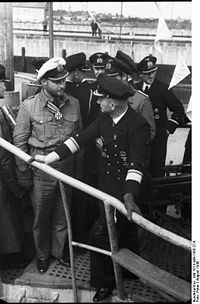 |
| 37 | Adalbert Schnee Adalbert Schnee Lieutenant Commander Adalbert Schnee was a Korvettenkapitän with the Kriegsmarine during World War II. He commanded the U-boats , , , and , sinking twenty-one merchant ships on twelve patrols, for a total of of Allied shipping, and received the Knight's Cross with Oak Leaves... |
12 | 23 | 96,547 tons | Adalbert Schnee (1913–1982) commanded , , in 11 patrols, sinking 21 merchant ships totalling 90,189 tons, and damaged three others (28,820 tons). He also sank two British auxiliary warships, and . After serving on the BdU Befehlshaber der U-Boote Befehlshaber der U-Boote was the title of the supreme commander of the Kriegsmarines U-boat Arm during World War II. The term also referred to the Command HQ of the U-boat arm itself.... staff from October 1942, Schnee took command of the Type XXI German Type XXI submarine Type XXI U-boats, also known as "Elektroboote", were the first submarines designed to operate primarily submerged, rather than as surface ships that could submerge as a means to escape detection or launch an attack.-Description:... , in September 1944, sailing on only a single short patrol between 3 and 6 May 1945 before surrendering. |
|
| 38 | Reinhard Suhren Reinhard Suhren Commander Reinhard "Teddy" Suhren was a German U-boat commander in World War II and younger brother of Korvettenkapitän and Knight's Cross of the Iron Cross recipient Gerd Suhren. Suhren began his U-boat career in March 1938... |
6 | 18 | 95,544 tons | 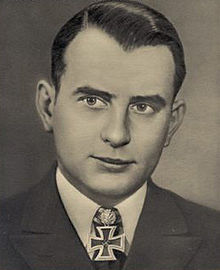 |
|
| 39 | Karl-Heinz Moehle Karl-Heinz Moehle Karl-Heinz Moehle was a German U-boat commander of the Second World War. From September 1939 until retiring from front line service in June 1941, he sank 21 ships for a total of . For this he received the Knight's Cross of the Iron Cross , among other commendations... |
10 | 21 | 93,197 tons | ||
| 40 | Georg-Wilhelm Schulz Georg-Wilhelm Schulz Georg-Wilhelm Schulz was a German U-boat commander of the Second World War. From September 1939 until retiring from front line service in September 1941, he sank 19 ships for a total of 89,885 GRT. For this he received the Knight's Cross, among other commendations.-Early life:Schulz was born on... |
8 | 19 | 89,886 tons | ||
| 41 | Georg Schewe Georg Schewe Georg Schewe was a famous Korvettenkapitän with the Kriegsmarine during World War II. He was also a recipient of the Knight's Cross of the Iron Cross... |
10 | 16 | 85,779 tons | ||
| 42 | Hans-Georg Friedrich Poske Fritz Poske Hans-Georg Friedrich "Fritz" Poske was a German U-boat commander in World War II and recipient of the Knight's Cross of the Iron Cross . The Knight's Cross of the Iron Cross was awarded to recognise extreme battlefield bravery or successful military leadership... |
4 | 16 | 85,299 tons | ||
| 43 | Ulrich Heyse Ulrich Heyse Ulrich Heyse was a German U-boat commander in World War II and recipient of the Knight's Cross of the Iron Cross... |
5 | 12 | 83,639 tons | ||
| 44 | Ulrich Folkers Ulrich Folkers Ulrich Folkers was a German U-boat commander in World War II and recipient of the Knight's Cross of the Iron Cross... |
5 | 17 | 82,873 tons | ||
| 45 | Herbert Kuppisch Herbert Kuppisch Herbert Kuppisch was a Kapitänleutnant with the Kriegsmarine during World War II and commander of U-58, U-94, U-516 and U-847... |
14 | 16 | 82,108 tons | 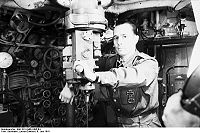 |
|
| 46 | Jürgen Wattenberg Jürgen Wattenberg Jürgen Wattenberg was a German naval officer and U-boat commander during the Second World War. In a successful career spanning just under a year, he sank 14 ships, a total of 82,027 gross registered tons .... |
3 | 14 | 82,027 tons | ||
| 47 | Rolf Mützelburg Rolf Mützelburg Kapitänleutnant Rolf Mützelburg was a German U-boat commander during World War II and a recipient of the Knight's Cross of the Iron Cross with Oak Leaves... |
8 | 19 | 81,987 tons | 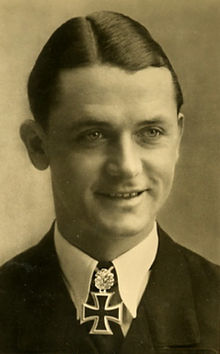 |
|
| 48 | Werner Winter Werner Winter Werner Winter was a German U-boat commander in World War II and recipient of the Knight's Cross of the Iron Cross... |
5 | 15 | 79,302 tons | ||
| 49 | Fritz Frauenheim Fritz Frauenheim Fritz Frauenheim was a German U-boat commander of the Second World War. From September 1939 until retiring from front line service in December 1940, he sank 19 ships for a total of , and damaged two others. For this he received the Knight's Cross of the Iron Cross , among other commendations... |
9 | 19 | 78,853 tons | ||
| 50 | Jürgen von Rosenstiel | 4 | 14 | 78,843 tons | Jürgen von Rosenstiel (1912–1942), commander of , sank 14 ships for a total of 78,843 GRT in only four patrols. On the last of these, on 5 July 1942, U-502 was sunk by a British Wellington Vickers Wellington The Vickers Wellington was a British twin-engine, long range medium bomber designed in the mid-1930s at Brooklands in Weybridge, Surrey, by Vickers-Armstrongs' Chief Designer, R. K. Pierson. It was widely used as a night bomber in the early years of the Second World War, before being displaced as a... bomber in the Bay of Biscay Bay of Biscay The Bay of Biscay is a gulf of the northeast Atlantic Ocean located south of the Celtic Sea. It lies along the western coast of France from Brest south to the Spanish border, and the northern coast of Spain west to Cape Ortegal, and is named in English after the province of Biscay, in the Spanish... . Rosenstiel and his crew were all killed. |

